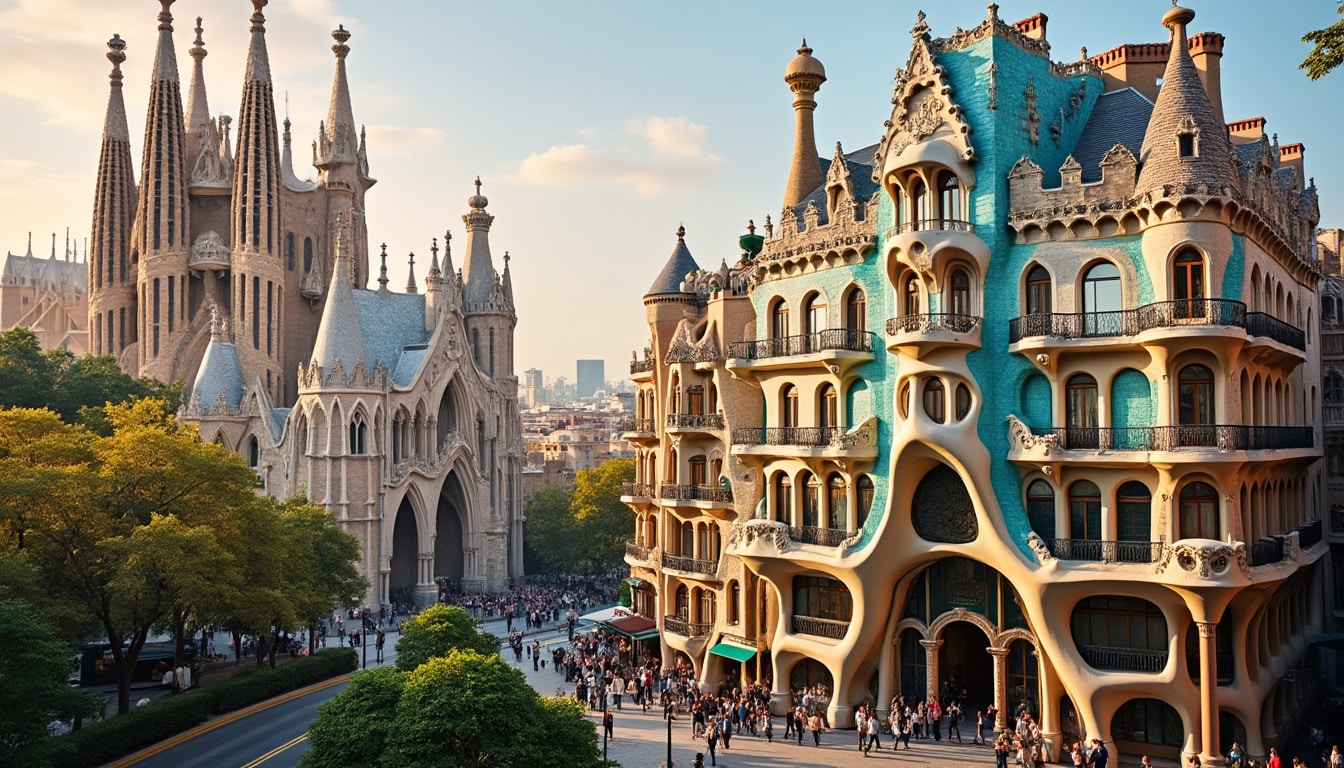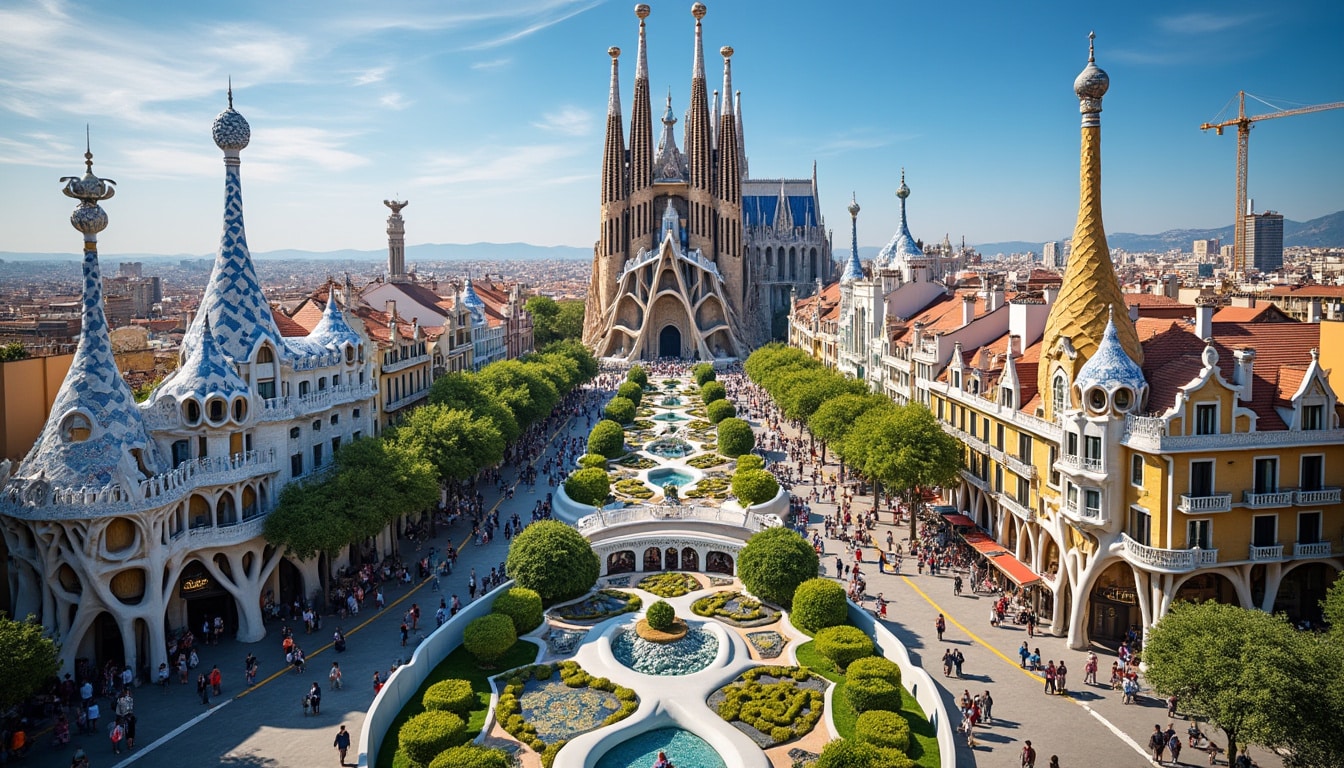Barcelona, a city where architectural traditions blend seamlessly with groundbreaking innovation, paints a vibrant picture of cultural evolution. It’s a cityscape where the ancient and the modern shake hands in a complex dance, witnessed by millions each year. From the Gothic cathedrals casting poetic shadows to Antoni Gaudí’s dreamlike creations such as the Sagrada Família and Casa Batlló, the architectural fabric of Barcelona is both enchanting and educational. Step through the grand streets of Eixample where urban planning brilliance unfolds, revealing an intricate grid system that transformed the city’s layout. The sprawling parks, like Parc Güell, offer sweeping views and curious designs interwoven with nature. Meanwhile, the bold lines of modern skyscrapers, including the luminescent Torre Glòries, signal a city embracing the 21st century. Embark on this journey to discover how Barcelona has become a living museum of architectural marvels and urban features.
The Flourishing of Catalan Modernisme: A Barcelona Architectural Triumph
In the late 19th century, Barcelona experienced an architectural renaissance known as Catalan Modernisme, or Catalan Modernism. This period marked a departure from traditional designs, adopting an avant-garde approach that embraced elaborate, organic motifs inspired by nature. At the center of this movement was Antoni Gaudí, whose whimsical style characterized countless landmarks throughout the city. Gaudí’s work, such as the legendary Sagrada Família, remains a definitive example of Modernisme’s imaginative spirit.

The innovation of Modernisme is vividly expressed in Gaudí’s Casa Batlló, where a fantastical blend of colors and forms creates an enchanting presence. The building’s facade is alive with vibrant tile mosaics and sculpted stone, leading to its moniker ‘the house of bones’. This fairy-tale-like appearance is complemented by an equally breathtaking interior, where light, space, and imagination dance in harmony.
An intriguing part of Barcelona’s architectural tale includes buildings like the Palau de la Música Catalana, designed by Lluís Domènech i Montaner. This UNESCO World Heritage Site represents a confluence of art, music, and design, featuring a ceiling of blue-and-gold stained glass that never fails to enthrall visitors. The modernista movement is further illustrated by Casa Amatller, a testament to creative audacity, with its distinct blend of Gothic and Romanesque features presented in a uniquely Catalan fashion.
- ✨ La Sagrada Família: Gaudí’s most ambitious work, still under construction.
- 🦎 Casa Batlló: Known for its dragon-inspired aesthetics.
- 🎶 Palau de la Música Catalana: A cortile of light where music and design harmonize.
- 🏰 Casa Amatller: A fusion of medieval and Catalan motifs.
The Modernisme movement not only redefined architecture but etched Catalan culture into each piece, ensuring these buildings are not merely structures but living, artistic ideologies. As you wander through the city, take a moment to explore the fascinating imprints left by this era, where stone speaks and stories flourish in colors and curves.
Barcelona’s Diverse Architectural Mix: From Gothic to Contemporary
Barcelona’s architectural panorama vividly captures its layered history — a delightful mix of Gothic solemnity interlaced with contemporary zest. The Gothic Quarter, a historical hub, echoes tales from the medieval past with its awe-inspiring structures like the Barcelona Cathedral or the striking Santa Maria del Mar. Walking through this area feels like stepping back in time, where each stone and archway whispers tales of yore.
Transitioning into the contemporary era, however, Barcelona surprises with its adaptability and forward-thinking urban design. The cityscape is punctuated by sleek, novel structures like the high-tech Torre Glòries, which illuminates the skyline with its vibrant play of colors, navigating the transition between day and night with flair. Another standout establishment is the cutting-edge W Barcelona, known as the ‘Hotel Vela’ due to its ship sail-like shape. This modern marvel stands proudly against the Mediterranean, offering luxury adorned in a contemporary design language.
Amidst these transformations, numerous new developments, like the captivating Barcelona Design Museum, blend with older structures to create a culturally rich landscape. This museum is a testament to Barcelona’s commitment to fostering creativity, showcasing innovative designs across the spectrum of arts and crafts.
| Era | Style | Notable Structures |
|---|---|---|
| Medieval | Gothic | Santa Maria del Mar, Gothic Cathedral |
| 19th Century | Modernisme | Sagrada Família, Casa Batlló |
| Contemporary | Modern | Torre Glòries, W Barcelona |
Each architectural transition narrates a different chapter of Barcelona’s evolution, maintaining a dialogue between tradition and innovation. The city’s daring blend of old and new continues to captivate architects and tourists alike, illustrating the seamless integration of diverse architectural philosophies.
The Revolutionary Eixample District: Urban Planning at Its Best
The visionary design of Barcelona’s Eixample District is a profound illustration of urban planning genius. Envisioned by engineer Ildefons Cerdà in the mid-19th century, this grid-like expansion is characterized by wide avenues and chamfered corners designed to improve traffic flow and sunlight access. Cerdà’s innovative use of space promoted social equality through communal courtyards, providing every resident with access to light and ventilation — a radical idea at the time.
Walking through Eixample, visitors are treated to an architectural feast, with each block offering a unique interpretation of modernist design. The district is home to some of Gaudí’s outstanding works, such as La Pedrera (Casa Milà), famous for its undulating stone facade and whimsical wrought-iron balconies resembling seaweed in the ocean’s currents.
The harmony of the Eixample’s layout encourages visitors to explore, drawing them into hidden spots where they may stumble upon architectural gems like Casa Amatller or Casa Lleó Morera. These masterpieces exhibit a playful mix of French Art Nouveau and local Catalan detail, revealing how artistry flourished under the broad canvas of the Eixample.
- 🌐 Grid Planning: Ensures optimal light exposure and circulation.
- 🏛️ Iconic Structures: La Pedrera and Casa Lleó Morera.
- 🎨 Artistic Freedom: Catalan creativity at its peak.
- 🏠 Community-Centric: Courtyards offer relaxation spaces.
This district laid the groundwork for future urban developments worldwide, influencing modern planning in cities such as New York and Paris. The Eixample’s multifaceted approach to architecture has turned it into a must-see for those eager to delve into the fine art of urban design in Barcelona. For more about daily life and meal times in the city, you can explore meal times in Barcelona.
Hidden Architectural Gems in Barcelona: Discovering the Unseen
While iconic attractions like La Sagrada Família and Casa Batlló dominate guidebooks, Barcelona’s lesser-known architectural gems provide an equally enriching experience. Hidden in plain sight, these structures offer a glimpse into the city’s creative past and present without the perpetual crowds.
Take, for instance, the colorful Santa Caterina Market, designed by Enric Miralles and Benedetta Tagliabue. This market is not only an epicenter for local culture but also an architectural wonder with its kaleidoscopic roof inspired by the fresh produce inside.
A hidden urban sanctuary awaits at Recinte Modernista de Sant Pau, a splendid hospital designed by Lluís Domènech i Montaner. The hospital’s art nouveau architecture is accompanied by serene gardens, providing a peaceful complement to its aesthetic appeal. For those captivated by contemporary art, the Barcelona Pavilion, designed by Mies van der Rohe, is a celebration of modernism’s minimalistic elegance.
| Hidden Gem | Location | Key Features |
|---|---|---|
| Santa Caterina Market | Old City | Colorful roof, vibrant marketplace |
| Recinte Modernista de Sant Pau | Eixample | Art Nouveau architecture, tranquil gardens |
| Barcelona Pavilion | Montjuïc | Minimalist design, sleek materials |
A journey through these sites unveils their subtle yet profound contributions to Barcelona’s architectural narrative, encouraging appreciation beyond the well-trodden tourist routes. To discover more about the city’s cultural landscape, including its language diversity, see languages in Barcelona.
The Evolution of Modern Skyscrapers and Their Role in Barcelona’s Skyline
As Barcelona propels itself into the future, modern skyscrapers have begun to punctuate the skyline, adding a vertical dimension previously unseen in this historical city. Standing tall amongst these is the Torre Glòries, an icon of modern design inspired by Montserrat’s natural landscape. Architect Jean Nouvel masterfully wove functionality and aesthetics into this stunning centerpiece, allowing it to serve both as an office space and an architectural marvel.
The creative design doesn’t stop with Torre Glòries. Another striking structure is the Diagonal ZeroZero, embodying sleek, geometric minimalism. The tower’s advanced technology and innovative design reflect Barcelona’s commitment to sustainable architecture and environmental sensitivity. Joining these is W Barcelona, or ‘Hotel Vela’, which captures the imagination with its sail-like shape, providing splendid views over the Mediterranean coastline.
The emergence of these skyscrapers signifies a shift in Barcelona’s architectural goals, embracing modernity and creating more space for thriving businesses and innovative ventures. Areas like the 22@ Innovation District reflect this forward-thinking ethos, promoting tech startups and creative industries within an urban ecosystem designed for future growth.
- 🏢 Torre Glòries: Nightly light display, modern workspace.
- 🌎 Diagonal ZeroZero: Echoes eco-friendly architecture.
- ⛵ W Barcelona: Iconic wavelike design, exquisite views.
- 💡 22@ District: Hub for technological innovation.
As the city continues expanding its horizons, integrating cutting-edge architecture with cultural heritage remains at the forefront of Barcelona’s development strategy. This dynamic evolution showcases how the city is prepared to tackle the challenges and opportunities of modern urban living. For more on these developments, take a look at best eateries in Barcelona, showcasing innovation in culinary arts alongside architectural advancement.
Frequently Asked Questions (FAQs)
Here are some frequently asked questions about the fascinating architecture of Barcelona:
- 🏰 What is the most recognized architectural style in Barcelona?
Barcelona is renowned for its Modernisme architecture, with Antoni Gaudí’s works being the most celebrated examples. - 🏙️ Can visitors enter most of Barcelona’s architectural landmarks?
Many landmarks, like Sagrada Família and Casa Batlló, offer interior tours, while others can be appreciated from the exterior. - 🌐 How has Barcelona influenced global urban design?
Barcelona’s innovative planning, particularly the Eixample District, has inspired urban designs worldwide due to its emphasis on accessibility and aesthetics.

